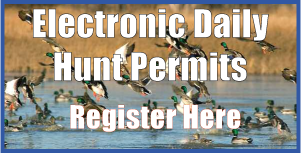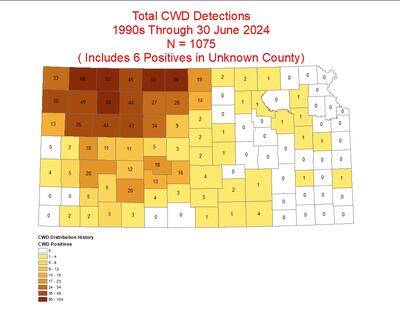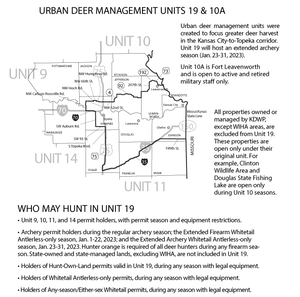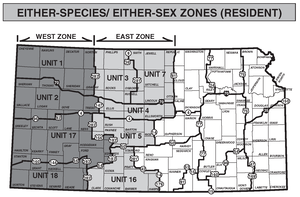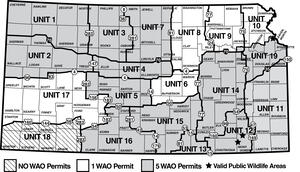Deer
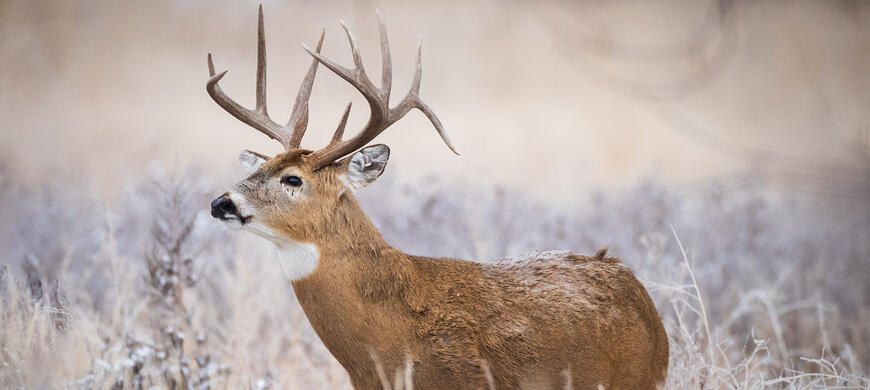
Two deer species thrive in Kansas – the mule deer and the white-tailed deer. Mule deer are restricted to the western one-third of the state, primarily on the High Plains, Smoky Hills, and Red Hills regions. As you travel west to east, mule deer are less abundant, and whitetail numbers increase. White-tailed deer numbers have increased dramatically in the last 20 years, and they can be found virtually statewide wherever suitable habitat exists. Highest whitetail densities are in the eastern one-third of the state. Whitetails have adapted well to Kansas’ modern landscape, finding cover in natural woodlands, shelterbelts, old homesteads and grasslands, and abundant food in cropfields. The selective management program has created a healthy deer herd, with excellent potential for trophy-sized bucks in all regions.
To apply or sign in to your account, go to gooutdoorskansas.com
Dates: 09/06/2025 - 09/14/2025
Youth 17 and younger, who possess a valid deer permit, may hunt during this special deer season only while under the immediate supervision of an adult 18 or older. Any person who possesses a valid deer permit and has a permit to hunt from a vehicle pursuant to K.A.R. 115-18-4 or a disability assistance permit issued pursuant to K.A.R. 115-18-15 may also hunt during this season. All resident and nonresident permits are valid, and equipment restrictions designated on permits apply. Hunter orange is required.
Dates: 09/15/2025 - 09/28/2025
The following permits may be used during this season in units specified on permit, using muzzleloader or archery equipment: Resident or Nonresident Muzzleloader Either-species/Either-sex Permit, Resident Any-Season White-tailed Deer Permit, Nonresident Muzzleloader White-tailed Deer Permit, Hunt-Own-Land Permit, Special Hunt-Own-Land Permit, Antlerless White-tailed Deer Permit, and Antlerless Either-Species Deer Permit. Hunter orange is required.
Dates: 09/15/2025 - 12/31/2025
Dates: 10/11/2025 - 10/13/2025
Any permit that allows the harvest of a white-tailed antlerless deer is valid during this season. Equipment and unit restrictions on permit apply. Hunter orange is required.
Dates: 10/14/2025 - 10/19/2025
Dates: 12/03/2025 - 12/14/2025
Dates: 01/01/2026 - 01/11/2026
Dates: 01/01/2026 - 01/04/2026
January Deer Season - Extended Firearms Whitetail Antlerless Only
Dates: 01/01/2026 - 01/18/2026
Dates: 01/19/2026 - 01/31/2026
The following unfilled permits are valid during this season using archery equipment only for antlerless whitetails: Resident and Nonresident Archery Either-species/Either-sex permit, Nonresident Archery White-tailed Deer permit, Resident Any-Season White-tailed Deer permit, Hunt-Own-Land Permit (valid for Unit 19), Special Hunt-Own-Land permit (valid for Unit 19), and Antlerless White-tailed Deer permit. A valid hunting license is required, unless exempt by Kansas law. NOTE: Unit 10A is Ft. Leavenworth and is open only to military personnel.
Deer Harvest Table for 2023-24 with statewide harvest by species, age and sex for each permit class.
Deer Harvest Table for 2022-23 with statewide harvest by species, age and sex for each permit class.
Deer Harvest Report for 2021-22, includes estimate of harvest by age/sex/species, weapon type, hunter effort, and harvest date.
Deer Harvest Report for 2020-21, includes estimate of harvest by age/sex/species, weapon type, hunter effort, and harvest date.
Hunter comments received during the 2019-20 Post-season Deer Harvest Survey. Comments are provided as written by the survey respondent, save that personal information and vulgarities have been removed.
Deer Harvest Report for 2019-20, includes estimate of harvest by age/sex/species, weapon type, hunter effort, and harvest date.
Deer Harvest Report for 2018-19, includes estimate of harvest by age/sex/species, weapon type, hunter effort, and harvest date.
Hunter comments received during the 2018-19 Post-season Deer Harvest Survey. Comments are provided as written by the survey respondent, save that personal information and vulgarities have been removed.
Hunter comments received during the 2017-18 Post-season Deer Harvest Survey. Comments are provided as written by the survey respondent, save that personal information and vulgarities have been removed.
KDWP is offering FREE, Limited Chronic Wasting Disease testing during the 2024-2025 deer seasons. For details, click "2024-2025 CWD Sampling Information" below or see CWD page in the 2024-2025 Kansas Hunting & Furharvesting Regulations Summary, here https://ksoutdoors.com/Hunting/Hunting-Regulations.
The first case of CWD was found in a captive bull elk in Harper County in 2001. As of 30 June 2024, CWD has been detected in 1075 cervids, including 2 captive elk, 1 captive mule deer, and 1072 wild, free-ranging deer. All Surveillance Zones in Kansas now have CWD detections. CWD surveillance began in 1996 and, to date, 36,038 cervids have been sampled and tested for CWD. Hunters and other wildlife enthusiasts can avoid the human-assisted spread of CWD by not transporting a live or dead deer or elk from areas where CWD occurs. HUNTERS ARE ENCOURAGED TO USE ELECTRONIC DEER CHECK-IN (E-TAG) OR LEAVE EVIDENCE OF SEX ATTACHED TO THE CARCASS. THEN, BONE-OUT DEER, AND LEAVE CARCASSES IN THE COUNTIES WHERE DEER ARE TAKEN. MOVING CARCASSES MOVES PRIONS AND CWD TO NEW LOCATIONS! There is currently no known treatment or eradication method for CWD, so preventing the introduction of the the disease into new areas is extremely important to maintaining the health of local deer herds. Baiting and feeding deer tend to concentrate deer at small point on the landscape, often with the trails leading to the feeding sites resembling the wheel spokes of a bicycle. Anytime animals are concentrated at this type of "hub," the likelihood of disease transmission increases in a deer herd. More alarming, the transferring of CWD prions to healthy deer is not the only concern. Diseases such as bovine tuberculosis, foot rot bacteria, fungal pathogens, hemorrhagic disease, and a host of detrimental parasites, including exotic lice, flukes, roundworms, mange mites, lungworms, and barberpole worms are transmitted more efficiently when deer are concentrated in a small area, especially around feeding stations. Think of future generations of hunters and do your best to lower wildlife disease transmission risk.
Other Important Information
1. No human has contracted CWD to date, but all scientists agree that the RISK IS NOT ZERO based on laboratory experiments.
2. KDWP does not recommend eating any sick wildlife, and a CWD-positive deer is considered sick wildlife, even though most positive deer look apparently healthy. Testing deer lymph nodes or obex is the only way to really know if a deer is negative or positive.
3. Normal cooking temperatures do not deactivate/denature CWD prions; they are very stable structures. It takes about 1100 degrees Fahrenheit to destroy prions.
Watch this video to learn how to extract the correct lymph nodes for CWD Testing.
https://www.youtube.com/watch?v=ygoOy0gldQM
Another major concern is the potential for CWD to spread from captive cervid farms into the wild cervid populations. Once a disease gets into a wild population of animals, it is virtually impossible eradicate. KDWP recommends that every captive cervid operator enroll in the voluntary CWD monitoring program administered by the Kansas Department of Agriculture, Animal Health Division. The sooner diseases such as CWD can be detected in captives, the sooner control efforts can begin and possibly prevent disease from getting outside the fence and spreading to wild populations of the state. CWD is only one of many diseases that could go undetected in an unmonitored captive cervid herd. Bovine tuberculosis and Foot and Mouth Disease (FMD), for example, are serious diseases that could seriously damage not only populations of deer and an annual 350 million-dollar hunting economy but could also threaten the 6 billion-dollar Kansas cattle industry via quarantines, loss of accreditation, and loss of global export.
IMPORTANT: Help Control the Spread of CWD and CWD Prions in Kansas!!
1. Complete an Electronic Check-In (E-Tag) for deer taken with Antlerless Only permits. Deer taken with Either Sex permits can be deboned in the field without Electronic-Deer-Check-In. The tag stays with the meat!
2. Remove the musculature (deboning) from the carcass and leave the carcass at the kill site. Make sure to complete Step 1 first.
3. If at all possible, do not transport a carcass from counties known to have CWD (see map to the right). Use electronic deer check-
in: https://programs.ksoutdoors.com/Programs/Electronic-Deer-Check-in for deer taken with Antlerless Only (AO) permits.
4. If you have to transport a whole carcass away from the kill site, take or send the deboned carcass, spinal column and head to your county landfill for disposal, once you have deboned the carcass at your place of processing. Don't carelessly discard this material where other deer and scavengers can contact it. Careless disposal of a cervid skeleton could potentially start a CWD hotspot in your area.
5. Keep the deer permit/tag with the meat. For more information about CWD, visit the CWD Alliance website at http://cwd-info.org/.
Click HERE for information concerning CWD Regulations for Resident and Non-Resident Hunters
National Wildlife Health Center (USGS) has links to current research and popular articles such as “The Quiet Spread of CWD” which appeared in Field & Stream.
Centers for Disease Control and Prevention has information about CWD and humans.
Chronic Wasting Disease Alliance has links to state regulations regarding CWD carcass
American Veterinary Medical Association has information about precautions hunters and anyone who spends time outdoors should take to protect themselves from potential risks.
| MANAGEMENT UNIT | 2024 RESIDENT EITHER SPECIES, EITHER SEX FIREARMS DEER PERMIT | PERMITS AUTHORIZED | # of Leftover Permits |
|---|---|---|---|
| WMD (UNITS 1,2,17,18) | EITHER SPECIES, EITHER SEX | 1072 | |
| EMD (UNITS 3,4,5,7,16) | EITHER SPECIES, EITHER SEX | 68 | |
Resident Either Species, Either Sex Deer Draw Stats Report
Nonresident Deer Draw Stats Report
| MANAGEMENT UNIT | 2025 NONRESIDENT DEER PERMIT TYPE | PERMITS AUTHORIZED | # of Leftover Permits | Date Leftover Permits Sold Out |
|---|---|---|---|---|
| UNIT 1 | WHITETAIL EITHER SEX | 451 | ||
| UNIT 1 | MULE DEER STAMP | 24 | ||
| UNIT 2 | WHITETAIL EITHER SEX | 313 | ||
| UNIT 2 | MULE DEER STAMP | 19 | ||
| UNIT 3 | WHITETAIL EITHER SEX | 739 | ||
| UNIT 4 | WHITETAIL EITHER SEX | 454 | ||
| UNIT 5 | WHITETAIL EITHER SEX | 659 | ||
| UNIT 6 | WHITETAIL EITHER SEX | 589 | ||
| UNIT 7 | WHITETAIL EITHER SEX | 1474 | ||
| UNIT 8 | WHITETAIL EITHER SEX | 1870 | ||
| UNIT 9 | WHITETAIL EITHER SEX | 1182 | ||
| UNIT 10 | WHITETAIL EITHER SEX | 1339 | ||
| UNIT 11 | WHITETAIL EITHER SEX | 3523 | ||
| UNIT 12 | WHITETAIL EITHER SEX | 2193 | ||
| UNIT 13 | WHITETAIL EITHER SEX | 636 | ||
| UNIT 14 | WHITETAIL EITHER SEX | 2019 | ||
| UNIT 15 | WHITETAIL EITHER SEX | 1658 | ||
| UNIT 16 | WHITETAIL EITHER SEX | 1765 | ||
| UNIT 17 | WHITETAIL EITHER SEX | 619 | ||
| UNIT 17 | MULE DEER STAMP | 38 | ||
| UNIT 18 | WHITETAIL EITHER SEX | 241 | ||
| UNIT 18 | MULE DEER STAMP | 19 |
Wild game processors are exempt from registration or regulation under Kansas law with the Kansas Department of Agriculture. This is complementary list of known deer processors across the state and may not be all inclusive. This list also include processors who are affiliated with the Hunters Feeding the Hungry organization.
Video on how to field dress a deer.
Kansas Deer Management Unit Maps. NOTE: Unit 10A is Fort Leavenworth and is open to active and retired military staff only.
Unit 19 Deer Management Map
Either Species - Either Sex Deer Zones
Antlerless White-Tailed Unit Map
Special Extended Seasons Deer Management Map
- Take a picture of the animal with your phone's camera making sure all the animal is visible.
- Open the Go Outdoors KS App and on the home screen, select "Harvest Reporting".
- On the "Harvest Reporting" screen you will see all your available tags.
- If you have multiple accounts on your phone, you can change to another account's available tags by selecting the name at the top of the screen. This will give you a list of everyone you have on your phone.
- Choose the tag you want to fill.
- Fill out the corresponding questions for the tag (harvest date, time, species, age, weapon used, unit and county).
- Click "Select Image" to select the picture you have taken of the animal.
- The last question, "Are you completing this Harvest Report for a Paper Carcass Tag?" If you are E-tagging select "No".
- Click "Submit" at the bottom and review all your answers for validation. Once reviewed click, "Submit" again.
- You should receive a popup success window with your E-tag confirmation number.
- If taking the animal to a processor or taxidermist, please write the confirmation down and attach it to the animal so it can stay with the animal.
To download the Go Outdoors KS mobile app to your Android device, visit: https://play.google.com/store/apps/details?id=com.brandtinfo.gooutdoorsks&hl=en_US&gl=US
To download the Go Outdoors KS mobile app to your Apple/iOS device, visit: https://apps.apple.com/us/app/gooutdoorsks/id1613997956
- Certificates are issued for racks or horns taken in Kansas which meet minimum scores as listed below. Hunter must possess a valid permit and trophy must have been taken by legal means during the legal open season.
- Scoring must be made by a certified Pope & Young, Boone & Crockett or Kansas measurer after a 60 day waiting period. Those scoring in the Kansas top 20 must be verified by a certified Pope & Young or Boone & Crockett measure.
- To keep records consistent with national lists, any scores listed with Boone & Crockett or Pope and Young Club's will be included in state records.
- The Chief of the Information and Education Section retains the right to reject any applications submitted to the Kansas Department of Wildlife and Parks.
- Any rack that has been altered will automatically be disqualified.
| Archery | Firearms | |
| Whitetail, Typical | 115 | 135 |
| Whitetail, Non-Typical | 120 | 150 |
| Mule, Typical | 135 | 150 |
| Mule, Non-Typical | 150 | 185 |
| Antelope | 50 | 70 |
| Elk, Typical | 220 | 300 |
| Elk, Non-Typical | 280 | 320 |







